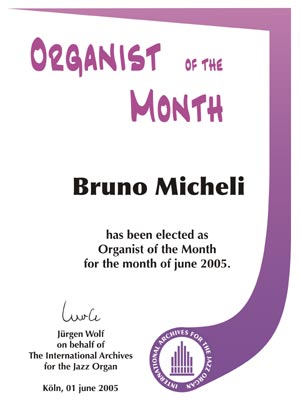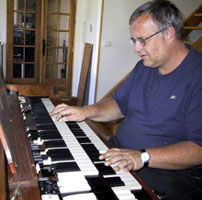Bruno tells his story
how he came to the organ:
I discovered the Hammond organ when I was 19 (in 1978), and I must admit that, as a pianist, I was a bit afraid of learning this instrument. The draw bars and the pedals were looking rather complicated to me.
I've always been filled with enthusiasm with the Hammond sound, but the opportunity to buy one arose when singer Diane Reeves started an European tour in May 2003. She demanded a B3 organ added to the piano. Obviously, for these gigs I used the B3 complementary only, I played it simply like a piano using only two presets (888 + 3rd percussion and full, with Leslie).
At end on this tour, the organ was transported to my home, and since that day I had been learning to play the B3 several hours per day, because I felt in love with this fabulous instrument, and I decided to record two or three titles playing the organ for my CD which had been registered these days ("Caravan"). At the end, I had used the organ on half of the album, but with the bass player Guillaume Bouchard and the drummer Dominic Schlocker, and some prestigious friends (Bresson, Mary, Bex).
At present time I'm working on the conception of my next album, and this time the Hammond B-3 will be heard on all titles, with left hand bass play and also pedals on one or two ballads.
I had difficulty to impose to my usual musicians the systematic use of the B3, but they now all want me to play on it every gig we do. Meanwhile, I have purchased the New B3P, the sound of which is identical to the original one, but far easier to move.
Today I would not consider to play on stage without using the B3 more than 90% of the time, and it can happen that I refuse a performance when I am requested only for piano or chromatic harmonica.
I still work sometimes with a bass player, but it is getting rarer because it is so exciting to keep control on the bass beat and tune harmony, this giving a far better freedom for improvisation.
Long live the Hammond organ! This instrument deserves it, and appearing a new generation of organists, more progressive than the previous one, will grant success to the Hammond organ, by means of which you can express yourself so fabulously.
Some technical remarks:
- I have now several original Hammond organs, each one having its own personality. I try to keep them in perfect condition with the help of the best European technicians. Some are fitted now with an effect loop circuitry, mainly for digital reverb device purpose, control of all reverb parameters for studio use provides an extra value. Some are upgraded with a string bass.
- I ordered some customization on my New B3P, to be able to connect to it any existing Leslie model, this giving me good versatility depending on needed sound characteristics, and available tone cabinets. I sometimes plug two Leslies.
Bruno Micheli
translation by Eric Wetzel
|



